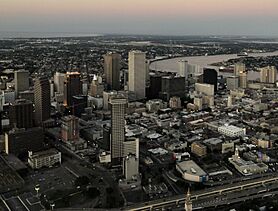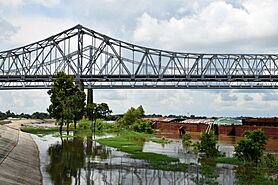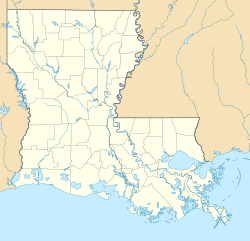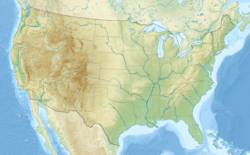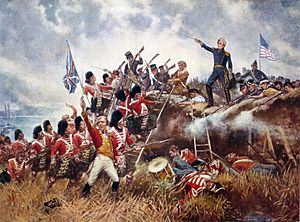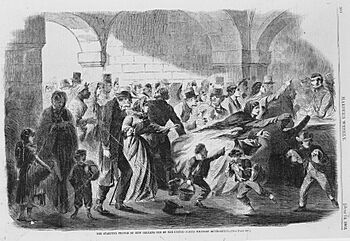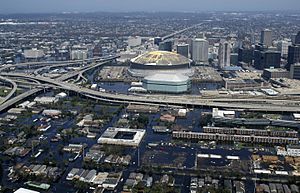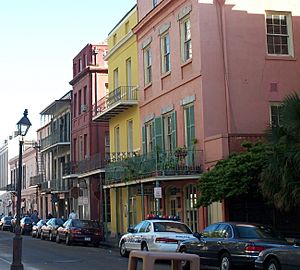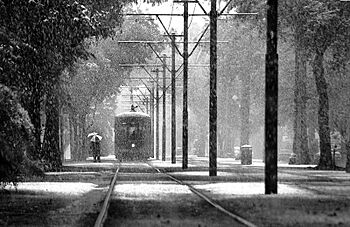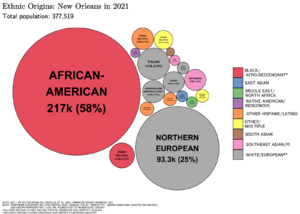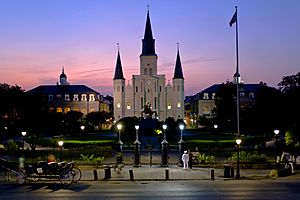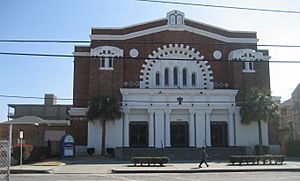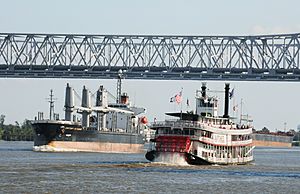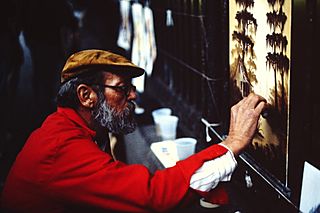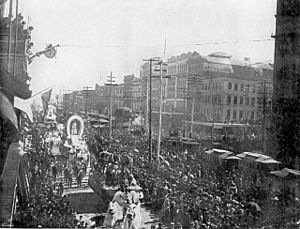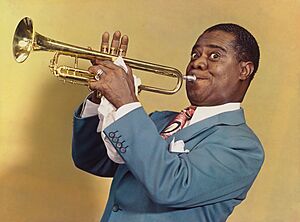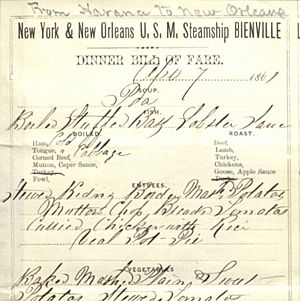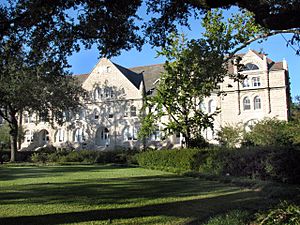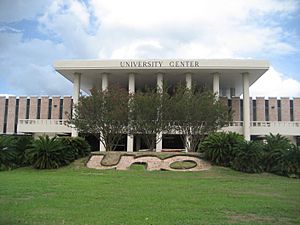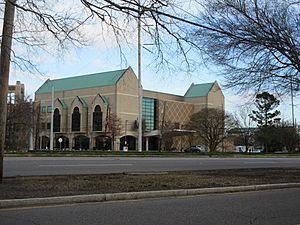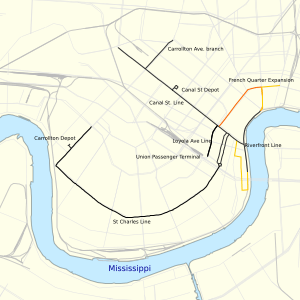New Orleans facts for kids
Quick facts for kids
New Orleans
La Nouvelle-Orléans (French)
Nouvèl Orleans (Louisiana Creole) |
|||||
|---|---|---|---|---|---|
|
Consolidated city-parish
|
|||||
|
Tulane University
Crescent City Connection
|
|||||
|
|||||
| Nicknames:
"The Crescent City", "The Big Easy", "The City That Care Forgot", "NOLA", "The City of Yes", "Hollywood South", "The Creole City"
|
|||||
| Country | United States | ||||
| State | Louisiana | ||||
| Parish | Orleans (coterminous) | ||||
| Founded | 1718 | ||||
| Founded by | Jean-Baptiste Le Moyne de Bienville | ||||
| Named for | Philippe II, Duke of Orléans (1674–1723) | ||||
| Government | |||||
| • Type | Mayor–council | ||||
| Area | |||||
| • Consolidated city-parish | 349.85 sq mi (906.10 km2) | ||||
| • Land | 169.42 sq mi (438.80 km2) | ||||
| • Water | 180.43 sq mi (467.30 km2) | ||||
| • Metro | 3,755.2 sq mi (9,726.6 km2) | ||||
| Elevation | −6.5 to 20 ft (−2 to 6 m) | ||||
| Population
(2020)
|
|||||
| • Consolidated city-parish | 383,997 | ||||
| • Estimate
(2024)
|
362,701 | ||||
| • Density | 2,267/sq mi (875/km2) | ||||
| • Urban | 963,212 (US: 49th) | ||||
| • Urban density | 3,563.8/sq mi (1,376.0/km2) | ||||
| • Metro | 1,007,275 (US: 59th) | ||||
| Demonym(s) | New Orleanian | ||||
| GDP | |||||
| • Consolidated city-parish | $29.482 billion (2023) | ||||
| • Metro | $102.437 billion (2023) | ||||
| Time zone | UTC−6 (CST) | ||||
| • Summer (DST) | UTC−5 (CDT) | ||||
| Area code(s) | 504 | ||||
| FIPS code | 22-55000 | ||||
| GNIS feature ID | 1629985 | ||||
New Orleans is a famous city in Louisiana, United States. It sits along the Mississippi River. Many people call it NOLA or The Big Easy. With about 383,997 residents in 2020, it is Louisiana's largest city. New Orleans is a major port and a busy center for trade.
The city is known worldwide for its special music, delicious Creole food, unique ways of speaking, and exciting festivals. The most famous festival is Mardi Gras. The historic French Quarter is the heart of the city. It has beautiful French and Spanish-style buildings and lively streets like Bourbon Street. New Orleans is often called one of the "most interesting" cities in the U.S. This is because of its rich mix of cultures and languages. It's also known as "Hollywood South" because many movies are filmed there.
French colonists founded New Orleans in 1718. It was the capital of French Louisiana. In 1803, the U.S. bought it in the Louisiana Purchase. By 1840, New Orleans was one of the biggest cities in the U.S. The city has always faced challenges from flooding. This is due to heavy rain, low elevation, and being near many bodies of water. Special systems of levees and pumps help protect the city.
In August 2005, Hurricane Katrina caused severe flooding in New Orleans. Over 80% of the city was underwater. Thousands of people had to leave their homes. Since then, the city has worked hard to rebuild and welcome residents back. By mid-2025, efforts to address root causes and reform the justice system had reduced violent crime to its lowest levels since the early 1970s.
Contents
- Discovering New Orleans: Names and Nicknames
- Exploring New Orleans' Past: A Journey Through Time
- New Orleans' Landscape: Geography and Climate
- People of New Orleans: Demographics and Culture
- New Orleans' Economy: A Hub of Activity
- New Orleans' Vibrant Culture and Daily Life
- Sports in New Orleans: Home of Champions
- National Protected Areas
- City Government and Education
- Media and Transportation
- Notable People
- Sister Cities
- See also
Discovering New Orleans: Names and Nicknames
Before Europeans arrived, the Choctaw people called this area Bulbancha. This means "land of many tongues." It likely referred to the many languages spoken near the Mississippi River.
The name New Orleans comes from the French name, La Nouvelle-Orléans. It honored Philippe II, Duke of Orléans, who was a ruler in France from 1715 to 1723. The French city of Orléans was named after a Roman emperor.
After France lost the Seven Years' War, it gave Louisiana to Spain in 1763. The Spanish called the city Nueva Orleans. In 1803, the U.S. bought the area and changed the name to New Orleans.
New Orleans has several fun nicknames:
- Crescent City: This name describes how the Lower Mississippi River curves around the city.
- The Big Easy: Musicians in the early 1900s might have used this name. It meant it was easy to find work there.
- The City that Care Forgot: This nickname suggests that people in New Orleans are relaxed and carefree.
- NOLA: This is a short way to say New Orleans, Louisiana.
Exploring New Orleans' Past: A Journey Through Time
Colonial Beginnings: French and Spanish Rule
La Nouvelle-Orléans (New Orleans) was founded in 1718. French colonists, led by Jean-Baptiste Le Moyne de Bienville, started the city. It was built on land where the Chitimacha people traditionally lived. The city was named after Philippe II, Duke of Orléans.
As a French colony, Louisiana faced challenges with Native American tribes. To address labor shortages, people were brought from Africa to work. Their traditions blended with French and Catholic influences. This created a unique Louisiana Creole culture. This culture included special music and language.
New Orleans quickly became an important port. It was a gateway for goods moving between North America and the Atlantic Ocean. The Ursuline sisters arrived in 1727. They helped educate girls and started schools that are still important today. Early city planners designed the streets and defenses.
In 1763, France gave Louisiana to the Spanish Empire. Many New Orleans residents did not like Spanish rule. They even tried to take control of the city in 1768. Most of the old buildings in the French Quarter today were built during the Spanish period. During the American Revolutionary War, New Orleans helped the American cause. Spanish governor Bernardo de Gálvez y Madrid, Count of Gálvez led efforts against the British from the city.
Becoming Part of the United States
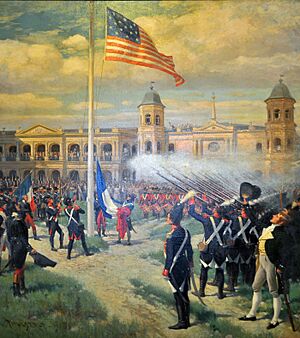
In 1800, France briefly regained control of New Orleans. But in 1803, Napoleon sold it to the United States as part of the Louisiana Purchase. After this, the city grew very fast. Many people moved there, including Americans, French, Creoles, and people from Africa. Later, immigrants from Ireland, Germany, Poland, and Italy also arrived.
Sugar and cotton were important crops grown on nearby large farms. Enslaved people were forced to work on these farms. Thousands of refugees from the Haitian Revolution also came to New Orleans. They brought their skills and helped develop the sugar industry. This also added to the city's French-speaking population and rich culture.
In 1811, a large group of enslaved people in nearby parishes rose up, seeking their freedom. This event, known as the German Coast uprising, was a significant moment in U.S. history.
The Battle of New Orleans and Growth
During the War of 1812, British forces tried to capture New Orleans. General Andrew Jackson led a diverse group of soldiers and local fighters. They bravely defeated the British in the Battle of New Orleans on January 8, 1815. This happened even though a peace treaty had already been signed.
New Orleans was a very important port before the American Civil War. It handled goods for export and import. The Mississippi River was busy with steamboats and other ships. New Orleans was also a major center for the trade of enslaved people. Many enslaved people were forcibly moved to the Deep South, contributing greatly to the city's economy.
At this time, New Orleans also had a large and successful community of free people of color. Many were educated and owned property. By 1840, New Orleans was one of the wealthiest and third-most populated cities in the U.S. However, the city also faced many outbreaks of diseases like yellow fever.
Civil War and Reconstruction: A Time of Change
The American Civil War brought big changes. In 1862, the Union Navy captured New Orleans. General Benjamin F. Butler became the military governor. He made some unpopular decisions, including ending French language teaching in city schools. English soon became the main language in business and government.
Because the city was captured early, it avoided the destruction many other Southern cities faced. During the war, many formerly enslaved people joined the Union Army. They formed regiments like the "Corps d'Afrique."
After the war, during Reconstruction, efforts were made to give citizenship and civil rights to freed people. Louisiana's new constitution in 1868 allowed all men to vote and created public schools for everyone. Both Black and white officials were elected. However, economic problems and conflicts made this a difficult time. Federal troops left in 1877, ending Reconstruction. In 1892, racially mixed unions in New Orleans held a large strike, winning many of their demands.
Challenges and Progress: The Jim Crow Era and 20th Century
After Reconstruction, new laws called Jim Crow laws were passed. These laws created racial segregation in public places. This meant Black and white people were kept separate. These laws also made it very hard for African Americans to vote.
A group of free people of color in New Orleans fought against these unfair laws. They took a case, Plessy v. Ferguson, to the U.S. Supreme Court in 1896. The court ruled that "separate but equal" facilities were legal. In reality, facilities for African Americans were often much worse. This was a very difficult time for race relations in the U.S.
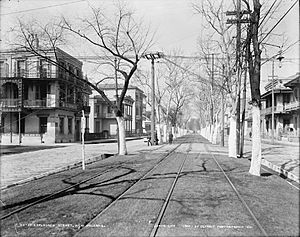
New Orleans's importance compared to other U.S. cities slowly declined in the 20th century. River traffic decreased as railways and highways grew. Many African Americans moved to other parts of the country for new opportunities.
The city was a key location during the Civil Rights Movement. In 1960, six-year-old Ruby Bridges became the first Black child to attend an all-white elementary school in the South. This was a major step in ending school segregation. New laws in the 1960s helped restore voting rights and end segregation.
Over time, New Orleans became more aware of its risk from hurricanes. Engineers worked on drainage systems. But scientists warned that the loss of coastal wetlands made the city more vulnerable to storms.
New Orleans in the 21st Century: Resilience and Recovery
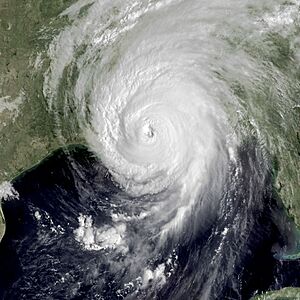
On August 29, 2005, Hurricane Katrina hit the Gulf Coast. The federal levee system around New Orleans failed. This caused massive flooding, putting 80% of the city underwater. Most residents had already evacuated. Thousands of people had to be rescued. Over 1,500 people died in Louisiana, mostly in New Orleans.
After Katrina, the city was closed to residents for a time. Many people moved away permanently. But federal, state, and local groups worked hard to rebuild. By 2007, the population had recovered to about 60% of what it was before Katrina. Ten years later, it was 80% recovered.
Major events and sports teams returned to the city. The New Orleans Saints football team and the New Orleans Pelicans basketball team came back. Festivals like Mardi Gras and the Jazz & Heritage Festival continued.
On August 29, 2021, Hurricane Ida, a very strong hurricane, made landfall nearby. On January 1, 2025, a serious truck attack occurred in New Orleans, killing 15 people and injuring 35. This was an act of domestic terrorism.
New Orleans' Landscape: Geography and Climate
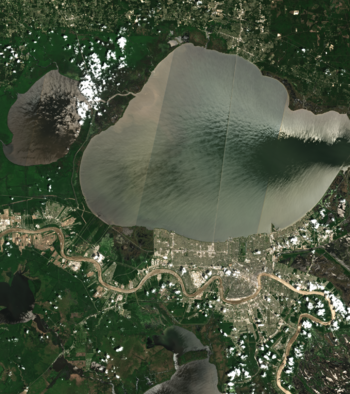
New Orleans is in the Mississippi River Delta, south of Lake Pontchartrain. It sits on the banks of the Mississippi River, about 105 miles (169 km) from the Gulf of Mexico. The city covers about 350 square miles (906 sq km), but more than half of that is water.
City Elevation: Living Below Sea Level
New Orleans was first built on higher ground near the river. Over time, engineers built levees and drained marshland. This allowed the city to grow into lower areas. Today, about half of the city is at or below sea level. The other half is slightly above. Some parts of the city are sinking slowly.
A study in 2016 found that about 65% of New Orleans is at or below the average level of Lake Pontchartrain. This means the city needs strong protection from water.
Cityscape: Neighborhoods and Architecture
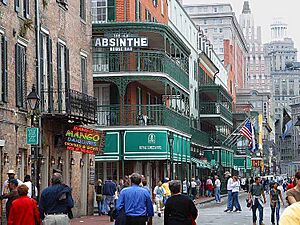
The Central Business District is north and west of the Mississippi River. It has many important streets like Canal Street. Canal Street divides the city into "downtown" (downriver) and "uptown" (upriver) areas.
Famous downtown neighborhoods include the French Quarter, Tremé, and Faubourg Marigny. Uptown neighborhoods include the Garden District and the University District.
New Orleans is famous for its many architectural styles. These styles show the city's mixed heritage. You can see Creole cottages, townhouses with iron balconies, and large antebellum homes on St. Charles Avenue. The city also has unique above-ground cemeteries.
Weather in New Orleans: A Humid Subtropical Climate
New Orleans has a humid subtropical climate. Winters are short and mild. Summers are hot and humid. The average temperature in January is about 54°F (12°C). In August, it's about 84°F (29°C).
The city gets about 62.5 inches (159 cm) of rain each year. Summers are the wettest months. Snow is very rare in New Orleans. The last significant snowfall was on January 21, 2025, when the city received 8–10 inches (20–25 cm) of snow.
Hurricane Threat: Protecting the City
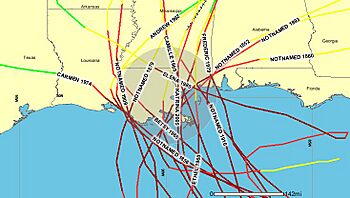
Hurricanes are a serious threat to New Orleans. The city is at risk because it is low-lying and surrounded by water. The Federal Emergency Management Agency says New Orleans is the most vulnerable U.S. city to hurricanes.
Many hurricanes have affected the area over the years. The flooding from Hurricane Katrina in 2005 was disastrous. It happened because the federal levee system failed.
Louisiana has lost a lot of its protective coastline due to human activity. After Hurricane Katrina, the Army Corps of Engineers greatly improved the city's flood protection. In 2006, Louisiana voters decided to use money from offshore drilling to restore the coast. Experts say that while levees reduce risk, they cannot offer complete protection in extreme storms.
People of New Orleans: Demographics and Culture
| Historical population | ||
|---|---|---|
| Year | Pop. | ±% |
| 1769 | 3,190 | — |
| 1778 | 3,060 | −4.1% |
| 1791 | 5,497 | +79.6% |
| 1810 | 17,242 | +213.7% |
| 1820 | 27,176 | +57.6% |
| 1830 | 46,082 | +69.6% |
| 1840 | 102,193 | +121.8% |
| 1850 | 116,375 | +13.9% |
| 1860 | 168,675 | +44.9% |
| 1870 | 191,418 | +13.5% |
| 1880 | 216,090 | +12.9% |
| 1890 | 242,039 | +12.0% |
| 1900 | 287,104 | +18.6% |
| 1910 | 339,075 | +18.1% |
| 1920 | 387,219 | +14.2% |
| 1930 | 458,762 | +18.5% |
| 1940 | 494,537 | +7.8% |
| 1950 | 570,445 | +15.3% |
| 1960 | 627,525 | +10.0% |
| 1970 | 593,471 | −5.4% |
| 1980 | 557,515 | −6.1% |
| 1990 | 496,938 | −10.9% |
| 2000 | 484,674 | −2.5% |
| 2010 | 343,829 | −29.1% |
| 2020 | 383,997 | +11.7% |
| 2024 (est.) | 362,701 | −5.5% |
| Population given for the City of New Orleans, not for Orleans Parish, before New Orleans absorbed suburbs and rural areas of Orleans Parish in 1874, since which time the city and parish have been coterminous. Population for Orleans Parish was 41,351 in 1820; 49,826 in 1830; 102,193 in 1840; 119,460 in 1850; 174,491 in 1860; and 191,418 in 1870. Source: U.S. Decennial Census Historical Population Figures 1790–1960 1900–1990 1990–2000 2010–2013 2020 estimate |
||
New Orleans's population grew steadily until 1960, reaching over 627,000 people. After that, the population started to decrease. This was due to changes in the economy and people moving to suburban areas. These shifts led to higher poverty levels in the city.
Hurricane Katrina in 2005 caused many people to leave. Black and African American residents, renters, and those with lower incomes were especially affected. After Katrina, the city's population began to recover. By 2020, it was 383,997. The city is now more diverse than before Katrina.
In 2010, most residents (90.3%) spoke English at home. Other languages spoken included Spanish (4.8%), Vietnamese (1.9%), and French (1.1%).
A Diverse Community: Race and Ethnicity
New Orleans has a rich mix of people from different backgrounds. In 2020, the city's population was about 53.6% Black or African American, 31.6% non-Hispanic White, and 8.1% Hispanic or Latino. The Hispanic and Latino population has grown a lot in recent years.
The city also has a growing Asian American community. The largest group is Vietnamese Americans, who came after the Vietnam War.
Faith and Traditions: Religion in New Orleans
New Orleans has a strong Roman Catholic history. This comes from its French and Spanish founders. Many schools and festivals, like Mardi Gras, show this Catholic influence. The statue of Our Lady of Prompt Succor is an important Catholic symbol.
The city also has many Protestant Christians. These include Baptists, Methodists, and Episcopalians.
New Orleans is known for its unique cultural traditions, including Louisiana Voodoo. This tradition blends African and Caribbean beliefs with Catholicism. Marie Laveau was a famous Voodoo practitioner. While Voodoo is often linked to the city, only a small number of people seriously practice it.
Jewish settlers have lived in New Orleans since the early 1800s. They helped found the first Jewish congregations. By the early 2000s, about 10,000 Jewish people lived in New Orleans. After Hurricane Katrina, this number dropped but has since grown again.
Muslims are also a visible religious group in New Orleans. Many are immigrants from the Middle East or African Americans.
New Orleans' Economy: A Hub of Activity
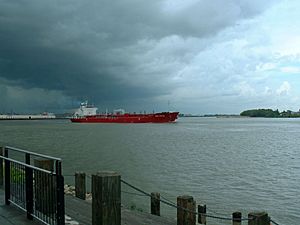
New Orleans has one of the world's largest and busiest ports. It's a key center for shipping and trade. The region is also important for oil refining and petrochemical production. Many companies involved in oil and natural gas have offices here. New Orleans has also become a growing technology hub.
The city is a center for higher learning, with many colleges and universities. Tulane University is a top research university. The health care industry is also a major part of the economy. New Orleans is famous for its cultural tourism.
The Port: A Gateway for Goods
The Port of New Orleans is one of the largest in the U.S. for cargo volume. When combined with the nearby Port of South Louisiana, it forms one of the world's busiest port systems. Many companies involved in shipping and logistics are based here. The world's largest coffee-roasting plant, run by Folgers, is in New Orleans East.
New Orleans is close to the Gulf of Mexico and its many oil rigs. Louisiana is a top state for oil and natural gas production. Several energy companies have offices in the area.
Business and Tourism: Driving the Economy
Entergy, a power company, is a Fortune 500 company based in New Orleans. Many other companies have important operations or headquarters in the city. These include companies in insurance, shipping, and food. New Orleans also supports new businesses and start-ups.
Tourism is a huge part of the city's economy. It brings in billions of dollars and creates many jobs. In 2004, 10.1 million visitors came to New Orleans. The city hosts major conventions and events like the World Cultural Economic Forum.
A 2009 poll called New Orleans one of "America's Favorite Cities." It was ranked best for things like "wild weekends," live music, and unique shops.
Federal and Military Presence
Federal agencies and the military have important facilities in New Orleans. NASA's Michoud Assembly Facility in New Orleans East is a huge manufacturing complex. It built parts for the Space Shuttles and is now used for the Space Launch System. The United States Department of Agriculture and the U.S. Navy also have facilities here.
New Orleans' Vibrant Culture and Daily Life
Visitor Attractions: What to See and Do
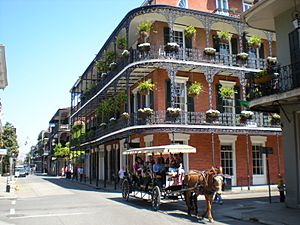
New Orleans has many exciting places to visit. The French Quarter is famous for its hotels, bars, and nightclubs. Key spots include Bourbon Street, Jackson Square, St. Louis Cathedral, and the French Market. You can also visit Café du Monde for delicious beignets and coffee.
Near the French Quarter is the Tremé community. It's home to the New Orleans Jazz National Historical Park and the New Orleans African American Museum.
You can take a ride on the Natchez steamboat along the Mississippi River. New Orleans's historic cemeteries are also unique. They have above-ground tombs, and the oldest is Saint Louis Cemetery.
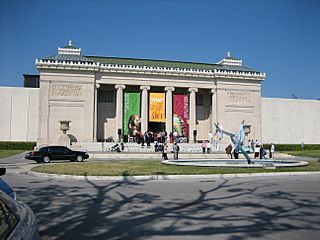
The National WWII Museum tells the story of World War II. Art lovers can visit the New Orleans Museum of Art (NOMA) in City Park. The Audubon Nature Institute has a park, zoo, aquarium, and insectarium. City Park is one of the largest urban parks in the country.
Festivals and Arts: A City of Celebration
New Orleans is known for its many annual celebrations. The most famous is Carnival, or Mardi Gras. It starts in early January and ends on "Fat Tuesday," the day before Lent.
The New Orleans Jazz & Heritage Festival (Jazz Fest) is one of the biggest music festivals in the U.S. Other major festivals include the Voodoo Experience and the Essence Music Festival.
Louisiana offers tax benefits for film and TV production. This has made New Orleans a popular place for filming, earning it the nickname "Hollywood South." Many movies and TV shows have been made here.
New Orleans has a rich musical history. It blends European, African, and Latino American cultures. The city is the birthplace of jazz music. This happened because enslaved people were allowed to gather and play their music in public, especially in Congo Square. Later, African American brass bands formed.
New Orleans also played a big role in rhythm and blues and rock and roll. It developed its own style of hip hop called bounce music. Famous musicians like Louis Armstrong and Frank Ocean come from New Orleans.
Delicious Flavors: New Orleans Cuisine
New Orleans is world-famous for its food. The local cuisine is unique and flavorful. It mixes French, Spanish, Italian, African, Native American, and Cajun traditions.
Some famous New Orleans dishes include:
- Beignets: Square-shaped fried dough, like French doughnuts, often served with coffee and chicory.
- Po' boy and muffuletta sandwiches.
- Fresh seafood like oysters and crawfish.
- Creole dishes like étouffée, jambalaya, and gumbo.
- Red beans and rice, a popular Monday meal.
- Pralines, a sweet candy made with pecans.
Unique Ways of Speaking: The New Orleans Dialect
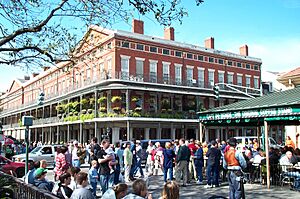
New Orleans has a special local accent. It's different from other Southern accents. One strong version is called the Yat dialect, from the greeting "Where y'at?" This accent is becoming less common in the city.
Some people in New Orleans still speak Louisiana French and Louisiana Creole. There's also a Spanish dialect called Isleño Spanish.
Sports in New Orleans: Home of Champions
New Orleans is home to professional sports teams:
- The New Orleans Saints (NFL football team), who won the Super Bowl in 2009.
- The New Orleans Pelicans (NBA basketball team).
The Caesars Superdome is where the Saints play. It has hosted the Super Bowl a record eight times. The Smoothie King Center is home to the Pelicans. New Orleans also hosts the annual Sugar Bowl college football game and the Jazz & Heritage Festival.
National Protected Areas
- Bayou Sauvage National Wildlife Refuge
- Jean Lafitte National Historical Park and Preserve
- New Orleans Jazz National Historical Park
- Vieux Carre Historic District
City Government and Education
How New Orleans is Governed
New Orleans is a city-parish government. This means the city and Orleans Parish work together as one government. The city has a mayor-council government. The mayor is the head of the city, and the city council has seven members. LaToya Cantrell became the first female mayor in 2018.
The city's government has faced challenges regarding paying court-ordered judgments, which is a complex issue.
Learning in New Orleans: Colleges and Schools
New Orleans has many colleges and universities. It has one of the highest numbers of higher education institutions in the Southern U.S. Some well-known universities include Tulane University, Loyola University New Orleans, and University of New Orleans. It also has several historically Black colleges and universities, like Xavier University of Louisiana and Dillard University.
After Hurricane Katrina, the public school system changed a lot. Most public schools became independent charter schools. This means they have more freedom in how they operate. This change allowed parents to choose which school their children attended. These charter schools have shown great improvement in student learning.
Libraries: Places to Read and Learn
New Orleans has many libraries for students and the public. The New Orleans Public Library has 13 locations. The main library keeps city records and special collections. University libraries, like the Monroe Library at Loyola and Howard-Tilton Memorial Library at Tulane, are also important resources.
Media and Transportation
News and Entertainment: Media in New Orleans
The main newspaper in New Orleans is The Times-Picayune/The New Orleans Advocate. There are also weekly publications like The Louisiana Weekly and Gambit Weekly.
New Orleans has many TV channels and radio stations. WWOZ is a famous radio station that plays jazz, blues, and other local music 24 hours a day.
Getting Around: Transportation in New Orleans
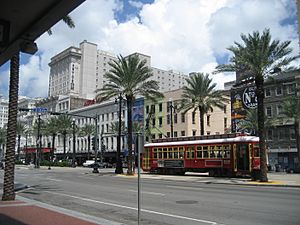
New Orleans has a unique streetcar system. There are four active lines, including the historic St. Charles Streetcar Line. The city's streetcars were even featured in a famous play, A Streetcar Named Desire.
The New Orleans Regional Transit Authority (RTA) also operates many bus routes. Ferries connect New Orleans with areas across the Mississippi River, like Algiers.
New Orleans is a great city for bicycle riding because it's flat. There are many bike lanes and trails, including the Lafitte Greenway.
Major highways like Interstate 10 serve the city. The Crescent City Connection is a large bridge that crosses the Mississippi River. The Lake Pontchartrain Causeway is one of the longest bridges in the world.
Airports and Rail Travel
The main airport for New Orleans is Louis Armstrong New Orleans International Airport. It's in the nearby suburb of Kenner. It's the busiest airport in Louisiana.
The city is also served by Amtrak trains at the New Orleans Union Passenger Terminal. Trains connect New Orleans to cities like New York City, Chicago, and Los Angeles.
Notable People
Sister Cities
New Orleans has sister cities around the world, helping to build friendships and cultural ties:
 Cap-Haïtien, Haiti
Cap-Haïtien, Haiti Caracas, Venezuela
Caracas, Venezuela Durban, South Africa
Durban, South Africa Innsbruck, Austria
Innsbruck, Austria Isola del Liri, Italy
Isola del Liri, Italy Juan-les-Pins (Antibes), France
Juan-les-Pins (Antibes), France Maracaibo, Venezuela
Maracaibo, Venezuela Matsue, Japan
Matsue, Japan Mérida, Mexico
Mérida, Mexico Orléans, France
Orléans, France Pointe-Noire, Republic of the Congo
Pointe-Noire, Republic of the Congo San Miguel de Tucumán, Argentina
San Miguel de Tucumán, Argentina Tainan, Taiwan
Tainan, Taiwan Tegucigalpa, Honduras
Tegucigalpa, Honduras
See also
 In Spanish: Nueva Orleans para niños
In Spanish: Nueva Orleans para niños
- Buildings and architecture of New Orleans
- The Cabildo
- French Quarter Festival
- List of people from New Orleans
- National Register of Historic Places listings in Orleans Parish, Louisiana
- Neighborhoods in New Orleans
- New Orleans in fiction
- New Orleans Union Passenger Terminal
- New Orleans Public Schools
- Pontalba Buildings
- The Presbytere
- Southern Food and Beverage Museum
- USS New Orleans, 5 ships
- USS Orleans Parish


